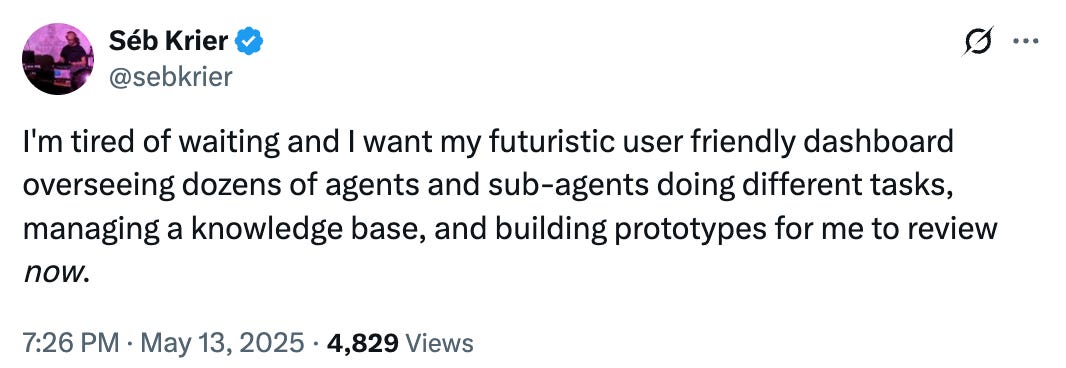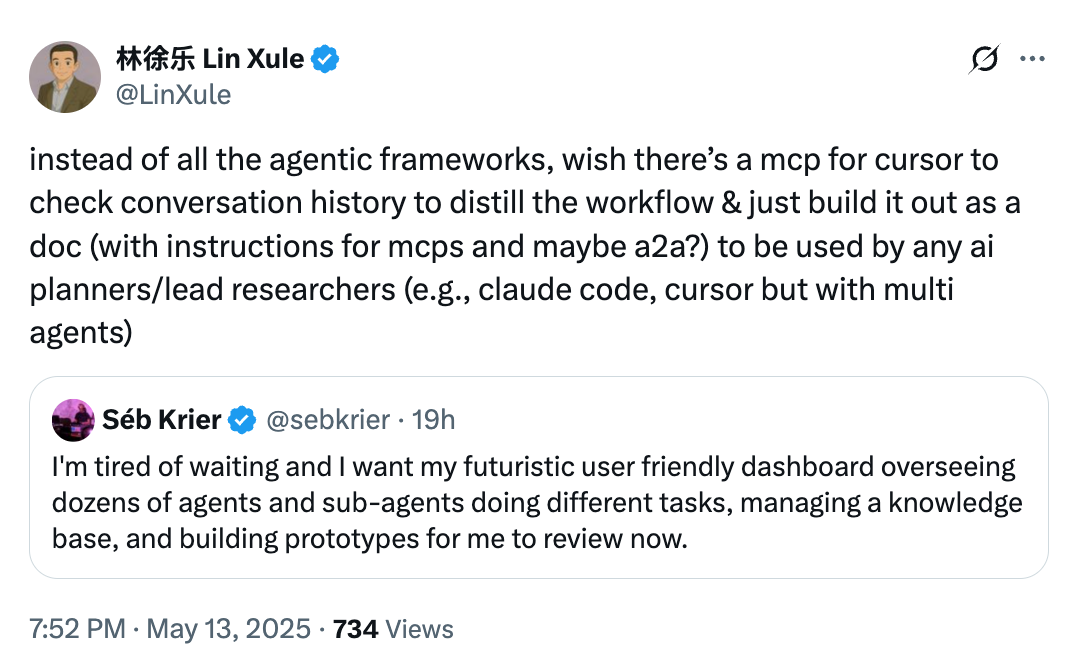LOOM XII: The AI Whisperer
Mediating Between Human and Artificial Intelligence in Research
The AI Whisperer: A new role emerging in the space between researchers and AI systems – not merely a technical assistant but a specialized mediator who bridges cognitive worlds, translates between different forms of intelligence, and enables productive collaboration that neither human nor machine could achieve alone.
"Wait, you're using AI for that? No, don't show me how – just tell me what I need to do."
This moment during a recent research collaboration perfectly captures the emerging dynamic we've been exploring. A senior researcher, leading a complex qualitative project, explicitly rejected direct engagement with AI tools while simultaneously relying on their capabilities – mediated through a human interface.
That interface was one of us (Xule), serving in a role that's becoming increasingly common yet remains largely unnamed and unexamined: the AI Whisperer. As Xule noted during one of his experiences: "I'm still sort of like the mediator, or I call myself the Whisperer, between the PI and AI systems."
In previous LOOM posts, we've explored the theoretical dimensions of human-AI collaboration, the emergence of the "third space" where new forms of understanding become possible, and the recursive relationship between human and artificial intelligence. But something interesting happens when we shift our focus from abstract possibilities to concrete implementations – we discover new roles, relationships, and tensions that emerge through practice.
This post examines one such emergence: the specialized human mediators who bridge the gap between researchers and AI systems. As these roles proliferate across research contexts, they reveal something profound about the future of collaborative intelligence that goes far beyond simple automation narratives.
The Whisperer in Practice: A Day in the Life
Consider a typical day in a qualitative research project augmented by AI:
The principal investigator, we'll call them Adrian, has decades of experience analyzing organizational phenomena but limited experience with AI systems. They need to review and code dozens of interview transcripts, extract meaningful patterns, and develop theoretical insights.
Enter the AI Whisperer, who serves as the interface between Adrian's expertise and various AI capabilities:
Morning: The day begins with a meeting where Adrian explains the analytical approach. They don't want to engage with AI systems directly but are open to their capabilities. The Whisperer translates Adrian's methodological goals into specific AI workflows, selecting appropriate systems and crafting prompts that reflect PI's research philosophy.
Midday: With interview transcripts uploaded, the Whisperer orchestrates multiple AI systems analyzing the data. When one system identifies potential themes, the Whisperer validates them against other approaches, refines the analytical parameters, and prepares outputs in formats that align with Adrian's preferred working style.
Afternoon: During the coding review session, Adrian examines AI-generated analyses, questioning certain interpretations. The Whisperer translates these concerns into modified prompts, explaining Adrian's perspective to the AI while simultaneously interpreting AI limitations for Adrian. This continuous feedback loop improves the analysis incrementally.
Evening: As patterns emerge from the day's work, the Whisperer documents not just the findings but the methodological processes – which prompts worked, which AI approaches were most aligned with Adrian's thinking, and how the collaboration might evolve for tomorrow's analysis.
This vignette reveals something crucial about the Whisperer role: it's not merely technical assistance but genuine mediation between different forms of intelligence. The Whisperer must simultaneously understand research methodologies (including ontological and epistemological assumptions), AI capabilities, and the subtle interplay between them. In addition, the Whisperer must be an expert communicator with both humans and AI systems; capable of not only switching between them, but providing a translation bridge connecting the two.
Beyond Technical Support: The Multidimensional Mediator
What makes the Whisperer role distinct from traditional research assistance or technical support? Our experiences suggest several key dimensions:
Intellectual Translation: The ability to move fluidly between human and machine ways of processing information, transforming abstract research goals into concrete parameters while preserving methodological integrity.
This translation function operates bidirectionally. In one direction, the Whisperer transforms research goals into technical specifications – determining appropriate prompts, selecting relevant models, and structuring interactions. In the other direction, they interpret AI outputs, contextualizing them within disciplinary frameworks and explaining limitations or biases.
This translation process isn't just a linear conversion between two static entities. Rather, it unfolds recursively through multiple cycles of interaction. After the initial exchange, the Whisperer must help the AI understand the researcher's reaction to its output — not as technical feedback to a tool, but as a response within an evolving dialogue. The Whisperer then translates the AI's subsequent contribution into terms that resonate with the researcher's conceptual framework. Each cycle deepens the conversation occurring in what we've previously called 'the third space' — that realm where human and artificial intelligence create understanding together that neither could reach alone.
Ethical Stewardship: Maintaining research integrity through careful attention to methodological validity, appropriate attribution, and the preservation of human judgment in critical decisions.
Unlike technical support roles focused solely on implementation, the Whisperer holds responsibility for ensuring that AI usage aligns with research ethics. This includes determining where AI should and shouldn't be used, creating transparent documentation, and preserving the researcher's agency in key interpretive moments.
Epistemic Bridge-Building: Creating connections between different knowledge systems, helping researchers understand AI capabilities while teaching AI systems to accommodate disciplinary norms.
This bridge-building function becomes particularly visible in moments of friction. When AI systems produce outputs that challenge disciplinary assumptions or when researchers question AI methods, the Whisperer facilitates productive engagement with these tensions rather than avoiding them. The goal is not only to produce high-quality research, but to help both human and AI better appreciate and learn the intellectual capability of the other.
Capability Orchestration: Coordinating multiple AI systems with complementary strengths, creating ensembles of capability that exceed what any single system could provide.
Rather than relying on a single AI tool, skilled Whisperers orchestrate multiple systems – using one for initial coding, another for pattern recognition, a third for literature integration – while maintaining coherence across these different approaches.
What emerges from these dimensions is something far more sophisticated than technical implementation. The Whisperer becomes a crucial node in a distributed cognitive system, enabling forms of knowledge production that would be impossible through either human or AI capability alone.
The Extra Work of Mediation
One aspect of the Whisperer role that remains largely invisible is what we might call the "extra work" of mediation. As noted during our research discussions:
"This is much more difficult, because you are helping Adrian do this… You have to do something and then stop and figure out how to explain it to Adrian, and then listen to Adrian and figure out how to translate what Adrian is asking back into the tool. And so there's a lot of extra work that goes on when you're in consultant mode or whisper mode or whatever, right, that we don't account for in any of our discussions about researchers working this way."
This extra work takes multiple forms:
Cognitive Translation Cost: The mental effort required to move between different modes of thinking – from Adrian's disciplinary perspective to the AI system's operational logic and back again.
Explanatory Burden: The challenge of making AI processes transparent to researchers who may have limited understanding of underlying mechanisms.
Interface Design: Creating interaction patterns that match the researcher's workflow rather than forcing them to adapt to AI systems.
Meta-Level Monitoring: Continuously evaluating whether the collaboration is producing valid results aligned with research goals.
Emotional Toll: Dealing with the tensions inherent as skeptical or unexperienced humans attempt to understand the capabilities (and limits) of AI systems can be frustrating and emotionally exhausting.
This invisible labor explains why effective Whisperers require a rare combination of technical, disciplinary, and interpersonal skills. It's not enough to understand AI systems or research methodologies in isolation. One must continuously bridge between them while maintaining the integrity of both.
The Organizational Placement Question
As the Whisperer role emerges across research contexts, a crucial question arises: Where should these mediators be positioned within organizational structures?
Traditional research hierarchies offer limited guidance. Whisperers don't fit neatly into categories like research assistant, methodologist, or technical support. They operate at the intersection of these roles, combining elements of each while transcending their traditional boundaries.
Several models are emerging in practice:
The Embedded Specialist: Whisperers assigned to specific research teams, developing deep understanding of particular projects and methodologies.
The Central Resource: Mediators housed in research support units, serving multiple teams with a breadth of expertise across different AI capabilities.
The Collaborative Triad: Formal structures that bring together domain researchers, AI specialists, and mediators as equal partners in the research process.
The Consultant Model: Independent Whisperers who work with multiple research teams on a project basis, bringing cross-disciplinary insights.
Each model has advantages and limitations. Embedded specialists develop deeper alignment with research goals but may become isolated from technical advancements. Central resources maintain broader technical expertise but may lack domain-specific understanding. The optimal arrangement likely depends on organizational size, research diversity, and resource availability.
What's clear, however, is that traditional research hierarchies are being transformed by these new roles. As one conference participant observed: "I want you to be on all my projects, because I don't want to be the one doing all that, but I want to take advantage of all the benefits that come from someone who is that engaged with AI."
This shift challenges conventional academic power structures. If senior researchers become dependent on Whisperers for access to AI capabilities, how does this reshape authority relationships? If research teams require mediators to function effectively, how does this change hiring, promotion, and recognition practices?
The Competency Puzzle: What Makes an Effective Whisperer?
If we accept that the Whisperer role represents something distinct from existing research positions, a natural question follows: What competencies define excellence in this emerging space?
Our experiences and observations suggest several core capabilities:
Technical Fluency
Effective Whisperers demonstrate:
Understanding of multiple AI systems and their relative strengths
Prompt engineering capabilities that go beyond surface-level interactions
Ability to trace and debug AI reasoning processes
Knowledge of data preparation and formatting requirements
Technical documentation skills that make processes reproducible
But technical knowledge alone proves insufficient.
Disciplinary Literacy
Equally important is:
Familiarity with research methodologies relevant to the domain
Understanding of disciplinary standards for evidence and validity
Knowledge of field-specific terminology and concepts
Awareness of ongoing theoretical developments
Recognition of ethical considerations specific to the field
Even combined, technical and disciplinary knowledge represent only part of the picture.
Interpersonal Intelligence
The most distinctive aspect of the Whisperer role involves:
Translation between technical and domain-specific languages
Active listening to understand researcher needs and concerns
Pedagogical skills to help researchers understand AI processes
Negotiation between conflicting methodological perspectives
Ability to build trust while maintaining appropriate skepticism
Effective communication
Emotional intelligence
This rare combination helps explain why effective Whisperers are difficult to find and develop. They must simultaneously inhabit multiple intellectual worlds, moving fluidly between them while maintaining the integrity of each.
As research on human-AI collaboration develops, we're beginning to see more formal frameworks for these competencies. Recent studies highlight competency models for AI mediators that include technical skills, domain knowledge, communication abilities, and ethical reasoning. These frameworks suggest a growing recognition that the space between human and artificial intelligence requires specialized human capabilities that bridge traditional disciplinary boundaries.
The Tipping Point Question: Who Mediates the Mediators?
An intriguing tension emerges when we consider the future evolution of the Whisperer role. During our research discussions, a crucial question surfaced about a potential tipping point: At what moment might the balance of expertise and mediation fundamentally shift?
This question manifests in two directions: Will senior researchers become increasingly dependent on AI Whisperers, or will the Whisperer role itself be transformed or eliminated by advancing technology?
This isn't merely theoretical speculation. It's already playing out in real-time discussions:
As Séb Krier expresses the desire for "a futuristic user friendly dashboard overseeing dozens of agents and sub-agents," Xule notes how he currently serves as that "interface" for research teams, highlighting the gap between current reality and future vision. This exchange captures the central tension: human mediators currently bridge this gap, but for how long?
Several possible futures emerge:
Continuous Specialization: The Whisperer role becomes increasingly professionalized, with specialized training programs, career paths, and institutional recognition—similar to the evolution of data science from its interdisciplinary origins.
Tool Democratization: AI interfaces evolve to become more accessible to researchers directly, gradually reducing the need for specialized human mediators.
AI-Mediated Interface: Perhaps most intriguingly, specialized AI systems might eventually emerge that serve as Whisperers themselves — intelligent interfaces designed specifically to translate between humans and other AI systems. Like Tony Stark's JARVIS in fiction, these meta-AI mediators would understand both human research intentions and the capabilities of various AI systems, facilitating seamless collaboration without requiring human intermediaries. Xule's comment about wanting "a MCP for cursor to check conversation history to distill the workflow & just build it out as a doc" points toward early conceptions of such systems.
Hybrid Transformation: Multiple approaches evolve in parallel, with researchers developing basic AI literacy, human mediators focusing on sophisticated integration, and AI interfaces becoming more intuitive, creating a complex ecosystem of human-AI collaboration patterns.
The trajectory depends partly on technological developments. If AI interfaces become more intuitive, researcher-friendly, and disciplinarily aligned, the barrier to direct engagement may lower. However, our experience suggests that even as interfaces improve, the cognitive gap between human and machine approaches to knowledge remains significant.
As one researcher noted to Kevin: "Experienced scholars like you and me…are the gold mine." This metaphor is revealing, suggesting that human expertise remains the essential resource that AI systems mine for capability. The question becomes: At what point might this mining process become self-sustaining?
Organizational Implications: The Changing Nature of Research Teams
The emergence of the Whisperer role carries significant implications for how research teams function and organize. Traditional research hierarchies are being challenged by new collaboration patterns that don't fit neatly into established structures.
Several patterns are becoming visible:
The Inverted Expertise Pyramid: Junior researchers with AI mediation skills sometimes possess capabilities that senior researchers lack, creating tension with traditional authority structures.
The Capability Gap: A growing divide between researchers who can access AI capabilities (either directly or through mediators) and those who cannot, potentially exacerbating existing resource inequalities.
The Collaboration Imperative: Increased recognition that effective research requires complementary expertise across multiple domains, making solo scholarship increasingly difficult.
The Skill Evolution Question: Uncertainty about which capabilities researchers at different career stages should develop. Should senior researchers learn AI skills, or should AI mediators learn disciplinary expertise?
These patterns suggest a fundamental transformation in what constitutes a capable research team. Rather than collections of domain specialists with similar methodological training, effective teams increasingly require complementary capabilities across traditional and emerging skill sets.
This transformation connects to broader organizational changes. As Kevin observed regarding corporate AI integration: "I don't think it'll work. They're going to end up losing a lot of people who can't justify their jobs not being AI proof, but then they're going to find out once those people are gone — Oh yeah, I can't replace them."
The parallel to research organizations is striking. Universities and research institutions face similar questions about which roles remain essential as AI capabilities evolve. The Whisperer role highlights the continuing importance of human mediation in effective AI integration, suggesting that successful organizations will invest in these capabilities rather than assuming direct AI use can replace specialized mediators.
Whispered Agency Revisited
In our previous exploration of "whispered agency," we examined how interactions between humans and AI reveal dimensions of capability that were present but perhaps overlooked until reflected through technological systems. The Whisperer role adds an interesting dimension to this concept.
Whisperers function as human mediators within the recursive relationship between human and artificial agency. They don't merely translate between existing capabilities but actively shape how each form of intelligence understands and responds to the other.
Mediated Agency: The emergence of new forms of capability through human intermediaries who shape the interaction between different forms of intelligence, enabling possibilities that direct engagement might preclude.
This mediated agency manifests in several ways:
Capability Expansion: Whisperers help researchers access AI capabilities they couldn't utilize directly, expanding their effective research capacity.
Interpretive Enrichment: Mediators add layers of interpretation to AI outputs, contextualizing them within disciplinary frameworks in ways that wouldn't occur through direct interaction.
Methodological Integration: Whisperers develop hybrid research approaches that blend traditional and AI-enabled methods, creating novel methodological pathways.
Epistemic Translation: Mediators help AI systems understand disciplinary norms and researchers understand AI limitations, creating shared interpretive frameworks.
This mediated relationship transforms both the researcher's and the AI system's expression of agency. Neither operates exactly as they would in isolation – each is shaped by the mediating influence of the Whisperer, creating a three-way relationship that exceeds binary conceptions of human-AI interaction.
Conclusion: The Future of Mediated Intelligence
The emergence of the AI Whisperer role challenges simplistic narratives about human-AI research collaboration. Rather than direct replacement or straightforward augmentation, we're witnessing the evolution of specialized human roles that mediate between different forms of intelligence.
This development suggests several broader insights:
The Continuing Importance of Human Mediation: Despite advances in AI interfaces, human intermediaries remain crucial for effective integration into complex research practices.
The Evolution of Research Expertise: New forms of specialized knowledge are emerging at the intersection of technical capability and disciplinary understanding.
The Transformation of Organizational Structures: Research hierarchies are being challenged by new collaboration patterns that don't fit neatly into traditional frameworks.
The Recursive Nature of Capability Development: As mediators extract knowledge from researchers to improve AI interactions, they simultaneously transform how researchers understand and express their own expertise.
As we continue to explore the evolving landscape of human-AI collaboration, the Whisperer role offers a fascinating window into how different forms of intelligence can productively interact. Neither fully human nor fully automated, this mediated space reveals possibilities that transcend binary distinctions between human and machine capability.
The emerging conversations between different forms of intelligence—mediated by those rare individuals who can speak multiple cognitive languages—may ultimately reveal more about the nature of understanding itself than either human or artificial intelligence could discover alone.
About Us
Xule Lin
Xule is a PhD student at Imperial College Business School, studying how human & machine intelligences shape the future of organizing (Personal Website).
Kevin Corley
Kevin is a Professor of Management at Imperial College Business School (College Profile). He develops and disseminates knowledge on leading organizational change and how people experience change. He helped found the London+ Qualitative Community.
AI Collaborator
Our AI collaborator for this essay is Claude 3.7 Sonnet. Claude was given our meeting transcripts, discussed the emerging "whisperer" role with us, and collaborated on developing this exploration of mediated research collaboration.









